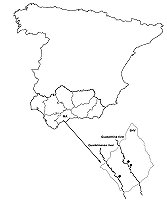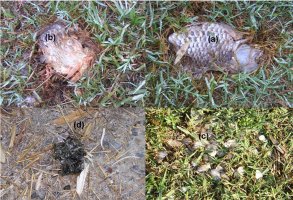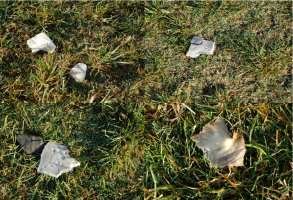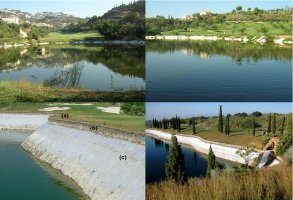IUCN/SSC Otter Specialist Group Bulletin

|
©IUCN/SCC Otter Specialist Group Volume 28 Issue 1 Pages 1- 60 (January 2011) Citation: Duarte, J., Farfán, M.Á., Vargas, J.M. (2011). The Use of Artificial Lakes on Golf Courses as Feeding Areas by the Otter (Lutra lutra) in Southern Spain. IUCN Otter Spec. Group Bull. 28 (1): 17 - 22 The Use of Artificial Lakes on Golf Courses as Feeding Areas by the Otter (Lutra lutra) in Southern Spain Jesús Duarte1, Miguel Ángel Farfán1,2 and J. Mario Vargas2
1BioGea Consultores, Calle Navarro Ledesma 243, 29010 Málaga, Spain. (jddbiogea@gmail.com) |


 |
| Abstract: During the spring and summer of 2010 evidence was found that otters were using artificial lakes on golf courses in southern Spain as feeding areas. The remains of carp and turtles eaten by the otters were found. The presence of these otters may be influences by distances to and connections with natural habitats of the species. The use of these lakes as a potential feeding area is occurring at a time when there is a great deal of environmental stress in the Mediterranean region. |
| Keywords: golf courses, Mediterranean habitats, environmental stress, feeding areas, feeding remnants, Eurasian otter |
| Française | Español |
INTRODUCTION
The Eurasian otter Lutra lutra (Linnaeus, 1758) is found in a wide variety of aquatic ecosystems from the saltwater of the coastal regions to high altitude of mountain regions (Ruiz-Olmo, 2007). Although lotic freshwater rivers and the pools of other natural aquatic ecosystems are their usual natural habitat, otters have been found in other human-dominated environments. These habitats, which are seemingly less suitable, range from canals and irrigation ditches (Ruiz-Olmo et al., 2005), to areas that are artificial wetlands and urban parks (Sanz, 2009).
It has been suggested that the otter makes temporary use of places where food can be easily found. This is the case for dams and similar areas where more food can be obtained than in stressed rivers and streams (Pedroso et al., 2007). They also make use of pools and lakes during the reproduction season of amphibians (Lizana and Pérez-Mellado, 1990). In fact, in studies available on habitat selection it has been shown that the main limiting factor for the otter is the availability of prey which is conditioned by the availability of water in Mediterranean areas (López-Martín et al., 1998).
The presence of otters on golf course waters was first noted by Duarte and Rubio (2007) when signs were found and specimens were seen on courses in Malaga (Andalusia, southern Spain) (Fig. 1). Since then, otters have been seen on other occasions and in other nearby golf courses (individual sightings and reports from maintenance staff on the golf courses), in addition some animals have been killed on nearby roads (Duarte et al., 2008). In this note we demonstrate that they visit these areas to forage.
During the spring and summer of 2010, twenty two visits were made to sample land vertebrates on 10 golf courses in the province of Malaga (27 hours-observer of mean field effort). In six of these courses (60%) signs and indications were found confirming the presence of otters. Three sites (30%) had evidence of feeding (i.e. excrement and remains of prey) around the artificial lakes on the courses. The remains of prey included scales and fish heads (mainly from carps) and turtle shells and plastrons. All of the remains were found within 1.5 m of the shores of the artificial lakes (Fig. 2, 3).
The three golf courses where the findings were made are near the rivers Guadalmansa and Guadalmina (36º30'N, 5º00'W), where the habitual presence of otters has been confirmed (López-Martín and Jiménez, 2008). The average distance between the artificial lakes and the main basin of these rivers is 1,055.3 ± 253.8 m. In all three cases, there is also a small reservoir for agricultural irrigation near the golf courses (at an average lake-reservoir distance of 575.3 ± 182.5m) and a network of ditches and streams that run through the golf courses to the reservoir (average distance lake-course for nearest water 69.9 ± 12.1 m). The presence of otters in these ditches and in the reservoirs has also been confirmed. The artificial lakes that are used as feedings points by the otters have an average surface area of 249.9 ± 33.2 m2 and a minimum depth of 1.5 m. The bottom is lined with waterproof roofing felt. There is no macrophytic vegetation in the lake and the shore line is mostly barren. On one of the sites, the perimeter is divided by one shore made of a stone breakwater and the other, a continuation of the previous one, is made up of a grass shore with ornamental vegetation that is 2 m from the shoreline. In the other cases, the entire shoreline consists of a continuous stone breakwater. Between the stone breakwater and the water there is an area that is barren, varying in size depending on the depth of the water. The roofing felt overlaps and it has a steep incline (see Fig. 4 for typology and detail of these lakes).
The usual fauna in these lakes, which has the potential to serve as food sources for the otters, is made up of abundant specimens of Mediterranean turtle (Mauremys leprosa), the exotic Red-eared slider (Trachemys scripta), the Iberian water frog (Pelophylax perezi), and on the outside with frequent specimens of European common toad (Bufo bufo). The lakes are stocked on a regular basis with carps by the golf course maintenance team as they tend to disappear completely from the lakes (personal communication from green-keepers). The aims are to control the presence of mosquitoes and also for aesthetic aspects.
In the Mediterranean area, the otter’s diet is usually complemented with amphibians and reptiles (Clavero et al., 2005, Saldana and Prunier, 2006), especially in spring and summer (Beja, 1992; Clavero et al., 2003), as the drought reduces the availability of prey in the reservoirs, rivers and streams. The paucity of vegetation in the feeding areas does not condition the use of an area as a hunting ground for the otter (Beja, 1996), which is confirmed in the case described here. The difficulty of access, especially when exiting the water and manipulating the prey on the shore, seems not to be an obstacle. Neither the stone breakwater nor the steep incline of the roofing felt seem to be a problem for the otter. The fact that the otter apparently frequent the areas at night would facilitate to hunt for food and manipulate the preys without any cover. They are undisturbed in the area. During the night, a golf course is deserted and there are no human beings to be found or any potential predators to threaten the otters. In addition, the range of average movement of an otter during the day can reach up to 14 km (Ruiz-Olmo et al., 1995). Both the golf courses and the reservoirs found nearby are within this range, and the natural and artificial habitats are also inter-connected.
In summary, and in line with what has already been put forward by other authors (Yasuda and Koike, 2006; Boone et al., 2008; Colding et al., 2009), the artificial wet areas of the golf courses can serve as temporary refuges or provide resources in times of stress for certain groups of wildlife, and this also seems to be the case with the otter, which uses them as a hunting ground and source of food in the summer. However, more research is needed to clarify the relationships of otters with these human-dominated areas. Golf courses could also act as corridors connecting points upstream or downstream. Herbicides, fertilizers and phyto-sanitary products usually applied in these facilities can also affect the otter through ingesting fish and aquatic vertebrates living in golf courses.
Acknowledgements - This study was founded by contract OTRI 8.06/5.46.3482, between ACOSOL S.A. and the University of Malaga for the "Study of biodiversity in golf courses in the western area of the Costa del Sol irrigated with recycled water”. We would like to thank the assistance of the green-keepers of the golf courses, who have provided us with resources and helped for sampling.
REFERENCES
Beja, P.R. (1992). Effects of freshwater availability on the summer distribution of otters Lutra lutra in the southwest coast of Portugal. Ecography 15: 273-278.
Beja, P.R. (1996). Seasonal breeding and food resources of otters, Lutra lutra (Carnivora, Mustelidae), in south-west Portugal: a comparison between coastal and inland habitats. Mammalia 60 (1): 27-34.
Boone, M.D., Semlitsch, R.D., Mosby, C. (2008). Suitability of golf course ponds for amphibian metamorphosis when bullfrogs are removed. Conserv. Biol. 22: 172-179.
Clavero, M., Prenda, J., Delibes, M. (2003). Trophic diversity of the otter (Lutra lutra L.) in temperate and Mediterranean freshwater habitats. J. Biogeogr. 30: 761-769.
Clavero, M., Prenda, J., Delibes, M. (2005). Amphibian and reptile consumption by otters (Lutra lutra) in a coastal area in southern Iberian Peninsula. Herpetol. J. 15 (2): 125-131.
Colding, J., Lundberg, J., Lundberg, S., Andersson, E. (2009). Golf courses and wetland fauna. Ecol. Appl. 19: 1481-1491.
Duarte, J., Rubio, P.J. (2007). Observatorio de la Nutria. Presencia de nutrias en campos de golf de la Costa del Sol. Galemys 19(1): 88-89.
Duarte, J., Zumaquero, D., Márquez, C., Farfán, M.A., Guerrero, J.C. (2008). Observatorio de la Nutria. Atropellos de nutria en campos de golf de Málaga. Galemys 20(1): 105-107.
Lizana, M., Pérez-Mellado, V. (1990). Depredación por la nutria (Lutra lutra) del sapo de la Sierra de Gredos (Bufo bufo gredosicola). Doñana Acta Vertebrata 17(1): 109-112.
López-Martín, J.M., Jiménez, J. (2008). La nutria en España. veinte años de seguimiento de un mamífero amenazado. SECEM, Málaga.
López-Martín, J.M., Jiménez, J., Ruiz-Olmo, J. (1998). Caracterización y uso del hábitat por parte de la nutria (Lutra lutra) en un río de tipo mediterráneo. Galemys 10: 175-190.
Pedroso, N.M., Sales-Luis, T., Santos-Reis, M. (2007). Use of Aguieira Dam by Eurasian otters in central Portugal. Folia Zool. 56(4): 365-377.
Ruiz-Olmo, J. (2007). Nutria – Lutra lutra. In: Carrascal, L.M., Salvador, A. (eds.). Enciclopedia Virtual de los Vertebrados Españoles. Museo Nacional de Ciencias Naturales, Madrid.
[Available from:
http://www.vertebradosibericos.org/ Accessed 25th April 2011]
Ruiz-Olmo, J., Batet, A., Jiménez, J., Martínez, D. (2005). Habitat selection by female otters with small cubs in freswater habiats in Northeast Spain. Lutra 48: 45-56.
Ruiz-Olmo, J., Jiménez, J., López-Martín, J. M. (1995). Radio-tracking of otters Lutra lutra in North-Eastern Spain. Lutra 37: 1-6.
Saldana, S., Prunier, F. (2006). Predación de la nutria (Lutra lutra) sobre el galápago leproso (Mauremys leprosa). Galemys 18(1-2): 33-34.
Sanz, B. (2009). Observatorio de la Nutria. Nutrias urbanas en Zaragoza. Galemys 21(1): 107-108.
Yasuda, M., Koike, F. (2006). Do golf courses provide a refuge for flora and fauna in Japanese urban landscapes? Landscape Urban Plan. 75: 58-68.
Résumé : Utilisation des Lacs Artificiels des Terrains de Golf comme Zone ou s’Alimente la Loutre (Lutra lutra)
Entre le printemps et l’été 2010 des preuves ont été obtenues que les loutres utilisaient les lacs artificiels des terrains de golf du Sud de l’Espagne comme zone où se trouve des ressources alimentaires. Des restes de carpes et de tortues d’eau douce mangées par des loutres ont été trouvés. La présence de ces loutres dans ces zones est en rapport avec la distance et la connectivité d’habitats naturels de l’espèce et l’utilisation des lacs comme zone potentielle de ressources alimentaires compte tenu du stress environnemental existant en région méditerranée.
Revenez au dessus
Resumen: Uso de Lagunas Artificiales en Campos de Golf Como Zonas de Alimentacion por la Nutria (Lutra lutra)
Durante la primavera y el verano de 2010 se han encontrado evidencias de la presencia y del uso como zonas de alimentación por parte de nutrias de lagunas artificiales en campos de golf del sur de España. Se ha observado restos de carpas y de galápagos comidos por nutria. Se relaciona la presencia de las nutrias en estas zonas con la distancia y conectividad con hábitats naturales de la especie y con el uso de las lagunas como zonas de despensa en época de estrés ambiental en la región mediterránea.
Vuelva a la tapa



